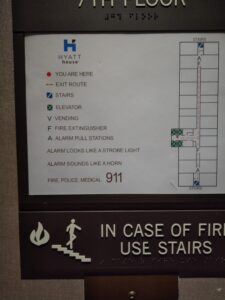
Poor quality writing usually only has modest consequences. In a bookstore, the consequence might be that the customer who considered buying a book puts it down and does not purchase it. In a teaching document, the consequence might be that the document does not explain things as well as might be desired, and the reader might have to read it twice to get its meaning.
Consider, though, the possible consequence of poor quality writing in an emergency sign in a public building. Here, the writer apparently had a goal of letting deaf persons know how to know that there is an alarm:
ALARM LOOKS LIKE A STROBE LIGHT.
The insertion of “looks like” needlessly adds a qualification that makes the reader wonder something like this:
Well, I wonder why they said this? I guess it is not actually a strobe light but in some way it merely “looks like” a strobe light. Do they mean that it is shaped like a strobe light or is encased in a clear plastic lens like a strobe light but is otherwise in some important way different from an actual strobe light?
I respectfully suggest that the writer could have saved everyone a lot of trouble by coming out and saying it rather than beating around the bush:
ALARM IS A STROBE LIGHT.
Better yet, the writer could have skipped completely any assumption that the reader already was familiar with strobe lights or, more particularly, that the reader knows what a strobe light “looks like”. The writer probably really should simply have said
IF YOU SEE A VERY BRIGHT FLASHING LIGHT, DO X.
We can also look at the sentence:
ALARM SOUNDS LIKE A HORN.
Once again I suggest the reader is unnecessarily forced to second-guess along these lines:
Okay, so I am hearing a horn. It cannot be the alarm, because they said the alarm merely “sounds like” a horn rather than saying that the alarm “is” a horn. So I wonder what is being communicated by this horn?
Better would have been to say:
ALARM IS A HORN.
or better yet:
IF YOU HEAR A VERY LOUD HORN, DO X.
How would you have worded such a sign? Please post a comment below.

If the goal is to inform deaf persons, better to start with the thing that is observed (the light) and then explain what that signifies (an alarm), i.e.: STROBE LIGHT IS AN ALARM
Yes, I think that is sensible. I also guess that most times a deaf person enters a public building, the person will have long ago received training that the bright flashing light has this meaning. In other words, I guess that when the person enters this particular public building, the chance that this sentence is telling the person anything that they did not already know is close to zero.
This might be sort of like the thirty seconds of everyone’s life that get put to complete waste every time an airplane takes off, explaining how to buckle a seat belt. The chances that a person did not already know how to buckle a seat belt are surely very nearly zero, yet this social cost gets incurred millions of times per year.
But back to the use of “strobe light.” I reiterate that one might as well avoid the completely unnecessary two-step communication. What good reason is there to assume that somehow the person already learned what “strobe light” means, namely “a bright flashing light”? Instead, why not skip directly to a single-step communication, avoiding the unnecessary middle communication step of defining a term as a first step ,and then using the defined term in a second step. Just come out and say what you mean: “Bright flashing light is an alarm.”
Is anyone hearing a horn and seeing bright flashing lights not going to recognize that’s an alarm? Telling me it’s an alarm isn’t useful; telling me what to do when the alarm occurs is. And in many tall buildings, the fire control people DO NOT WANT you to go down the stairs right away, or try to go all the way to the ground, but to stay by the stairway door until instructed to go down, and then only to go to a nearby floor.
Something that always bothers me is the sign “IN CASE OF FIRE USE STAIRS”. To me, it means “in case there is a fire, which there might not be, use the stairs”. Sort of like “in case of rain, bring your umbrella”…
A more clear sign would be “in the event of a fire, use stairs”… I understand that there is probably limited space (or because of engraving/signage costs)… so one could even write “IN EVENT OF FIRE, USE STAIRS”, or more simply “IF FIRE, USE STAIRS”.
Well the weird thing about “in case of fire use stairs” is that what the writer is almost always really trying to say is something completely different namely “if there is a fire, whatever you do, don’t try to use the elevator”. The fact is, if there is a fire maybe you don’t want to go anywhere at all. Maybe you want to shelter in place (for example if you are in a wheelchair). And the thing is, in most buildings nowadays, once the fire alarm gets pulled, the elevator will get summoned to the ground floor anyway and the door will open and the elevator won’t go anywhere except under control of the fire person key. So the actual real meaning of “in case of fire use stairs” nowadays is actually really “if there is a fire, whatever you do, don’t stand there smacking the elevator call button because we are telling you now, the elevator will never come and if you decide you do want to go to a different floor, you will have to take the stairs”.